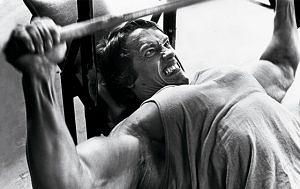‘How do I know what weight to start with?’
I know the feeling of enthusiastically reading a new program and wanting to tear it up in the gym immediately.
The First Few Weeks
What do you do next?
At this point you’ll find you’re coming closer to failure more often, and will start to see drop offs in reps in your 2nd and 3rd sets.
So what was previously 3 sets of 8 may now become 8,7,6. This is fine, and what should typically happen.
Why I Use Rep Ranges
The reason for doing this is because people will vary in how well they can handle weights across multiple sets.
If in the above example I wrote 3 sets of 8 instead, you might fight tooth and nail with no regards to form to reach 8 reps on the last set, when you should have stopped at 6.
If you can get all your working sets at the same weight, by all means do it.
Continuing with the 3 sets of 6-8 of bench press example, this is how it may look over the course of 8 weeks…
1 | 60kg | 8,8,8
2 | 62.5kg | 8,8,8
3 | 65kg | 8,7,7
4 | 65kg | 8,8,8
5 | 67.5kg | 8,7,6
6 | 67.5kg | 8,8,7
7 | 67.5kg | 8,8,8
8 | 70kg | 7,7,6
What if I always drop off in reps regardless?
If this sounds like you, you’ll never get 3 sets of 8 in the above example, and will always be stuck at perhaps 8,7,7.
In this scenario, don’t wait for the day you get to 3 sets of 8 to add weight. As soon as you get 8 reps on the first set with a rep or two spare (i.e. you’ve dominated the weight), add weight.
Here’s an example straight out of my logbook with the floor press, trained for 3 sets of 3-5 reps.
1 | 95kg | 5,5,5
2 | 97.5kg | 5,5,5
3 | 100kg | 5,5,4
4 | 102.5kg | 4,3,3 (felt heavy)
5 | 102.5kg | 4,4,4
6 | 102.5kg | 5,4,4
7 | 105kg | 4,4,3
8 | 105kg | 4,4,5 (freak last set!)
9 | 105kg | 5,5,4
As you’ll notice, patience is key.
I typically like to stick with weights for a few weeks, work on improving the rep quality and technique, and then when the first set hits the top of the required rep range (and feels good), I bump it up.
You’ll also see that in the first two weeks, I was lifting sub maximally to ‘break in’ to the new program – to make sure I didn’t plateau too quickly.
Reverse Pyramiding
If this sounds like you, an option is to warm up to your heaviest set, and then pyramid down on the next sets to stay in the rep range.
Taking the bench press example further, a workout could be as follows: 70kg for 8, 67.5kg for 8, 65kg for 8.
To progress, your main focus should be on improving your first set, and then on making sure your overall workload is going up.
When you can achieve the top end of the rep range for your first set, you’ll increase the load. For the sets after, typically a 5-10% drop works wells, and these should be progressed independently as needed.
How Do I Make The Jump Between Dumbbells?
For example, let’s say your workout calls for 3 sets of 10-12 on the incline dumbbell press.
Last week you got 20kg for 3 sets of 12. The problem is, the next ones up are 22.5kg and it’s too large a jump to be able to perform all 3 sets with.
So instead, here’s how you can ‘break in’ strategically to transition to heavier weights and create progression:
Workout | Load | Reps Achieved
1 | 20kg | 12,12,12
2 | 22.5kg20kg | 10,912
3 | 22.5kg20kg | 11,1012
4 | 22.5kg20kg | 12,1012
5 | 22.5kg | 12,11,10
6 | 22.5kg | 12,12,11
7 | 25kg22.5kg | 10,811
8 | 25kg22.5kg | 11,912
10 | 25kg22.5kg | 12,1012
This is just an example of how it may look. People vary massively in how they respond to multiple sets, so it’s important to listen to your body and notice how/if it drops off.
When you figure out the best strategy that works for you, you’ll notice your strength in the gym week to week will begin to take off.
Advance Use Of Reverse Pyramids
Here’s an example of an advanced strategy to use if you’re experienced in using reverse pyramids, that I’ve laid out in a ‘push’ workout:
- Smith Shoulder Press – 1 set of 4-6, 1 set of 6-8
- Dip – 3 sets of 8-10 – use a 10% drop off each set
- Machine Chest Press – use a 10% drop off each set
After progressively heavier warm up sets (with low reps to conserve energy), you’ll go for it on the first set, stopping at or maybe 1 rep shy of failure.

When you perform this method of training, it’s easy to think you have to go to failure on every set to make it work. Personally I’ve found better results with picking one set to go hell for leather on, and then keeping a rep in the tank for the others.
This way you’ll keep neural stress lower and prevent any early burnout on a training cycle.
Conclusion
- Always start a new program on the lighter side
- Milk linear progression for what it’s worth
- When you can reach the top end of the rep range with good form, increase the weight
- Learn how your body responds to multiple sets
- If you tend to always drop off, make your first set your gauge on when to increase the weight

.png)